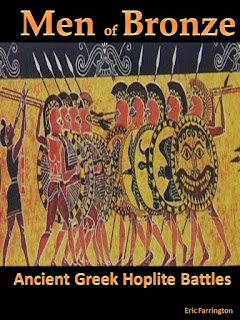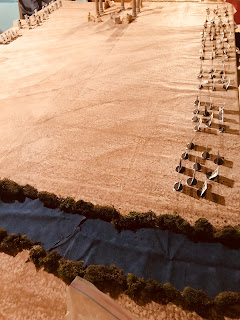 Herodotus tells us a great deal about the Ionian Revolt. Ionia was Greek colonies along the coast and edges of Turkey that had been captured and absorbed into the Persian Empire around 540 B.C.E. In 499 B.C.E the Tyrant of Miletus, Aristagoras; failed to capture the island of Naxos. This left him in a bad political position with his Persian overlords. In a desperate bid, he decided to stir revolt amongst his people against the Persians. This led many other local cities to cast off their Persian based Tyrants and replace them with Democracies.
Herodotus tells us a great deal about the Ionian Revolt. Ionia was Greek colonies along the coast and edges of Turkey that had been captured and absorbed into the Persian Empire around 540 B.C.E. In 499 B.C.E the Tyrant of Miletus, Aristagoras; failed to capture the island of Naxos. This left him in a bad political position with his Persian overlords. In a desperate bid, he decided to stir revolt amongst his people against the Persians. This led many other local cities to cast off their Persian based Tyrants and replace them with Democracies.
The Ionian Revolt had initial success in 498 B.C.E. when the allied Greek forces (including Athens, Eretria, and Ionians) managed to successfully attack Sardis. Sardis was the seat of a Persian Satrap and one of the personal enemies of Aristagoras. However, this minor victory was soon off-set by the Battle of Ephesus where Persian cavalry chased down and defeated the Greek forces.
Despite the loss, the revolt spread further. It spread to the Hellespont and Propontis. The city of the Carians also joined the revolt. In addition, Cyprus also revolted. Persian rule was in danger across the region, it was only a matter of time before the might of the Persian army would respond.
In 497 B.C.E., The Persian King had three generals appointed to put down the revolt. The three Persians (Daurises, Hymaees, and Otanes) divided the area into three partitions and attacked. Their attacks spread across the region. The battles and sieges for this period are largely unknown, with only a few details of the battles coming down to us from archeology and Herodotus.
Today’s battle will be one of those lost battles. Hymaees marched to the Propontis and attacked the city of Cius. Historically, he took the city. However, no details remain. Below I will be fighting a battle between the Persian general Hymaees and the defenders of the City of Cius. For the purposes of this battle, the citizen militia has come out of the city to fight off the Persian force. The ForcesNo details remain for the fall of the city of Cius. We only know that Hymaees took the city with his army while his fellow Persians attacked in other areas. Therefore, I will be using some standard armies from the Greek and Persian lists. The exact details of the true armies are not available.
Greeks3 Militia Hoplites
2 Peltasts
1 Archer Unit
1 Psiloi
Persians3 Archer Units
3 Drilled Infantry Unit
1 Psiloi
This is equal points in the system and should prove an interesting game.
 Deployment
DeploymentThis battle will be on a 6x4 board with both forces deployed on the long table edges. The Greeks on the North side with the Persians coming from the South. The Western edge of the battlefield is anchored on a river. The Eastern edge has the ruins of a temple sacked by the marauding Persian recon troops. The river is Dangerous terrain while the temple is Difficult.

The Greeks of Cius to the North have anchored there right flank to the river. They deployed across the battlefield in a battle line 6 base widths in. From right to left the units are; psiloi, archers, the 3 militia hoplites in phalanx are the core, then the 2 peltast units deployed across from the temple. The Persians face off against the Greeks also anchoring their left flank on the river banks. They are deployed alternating archers and drilled infantry, with the Persian right being anchored by Psiloi light troops across from the temple.

You can read the full details and final results of the battle here:
https://bloodandspectacles.blogspot.com ... le-of.html_________________
Do you like Free Wargames?
http://bloodandspectacles.blogspot.com/







